I recently posted about maintaining family routines, structure, and rhythms on the go. You may be wondering how this all plays out with time zone changes and jet lag. How can family routines and rhythms stay consistent when you are suddenly springing forward 8 hours after a sleepless night flying across the globe? Changing time zones with baby or toddlers in tow can be daunting, but don’t let that stop you from going on your next big adventure.
Our goal when we travel is to make it seem like nothing about the way our kids’ days are structured is different. In this post I lay out my top tips for helping your children get some sleep on the plane and avoid jet lag. I also cover how to help kids with jet lag once it hits. Make sure to scroll to the end for an example of how we would handle a typical overnight flight from the USA to Europe.
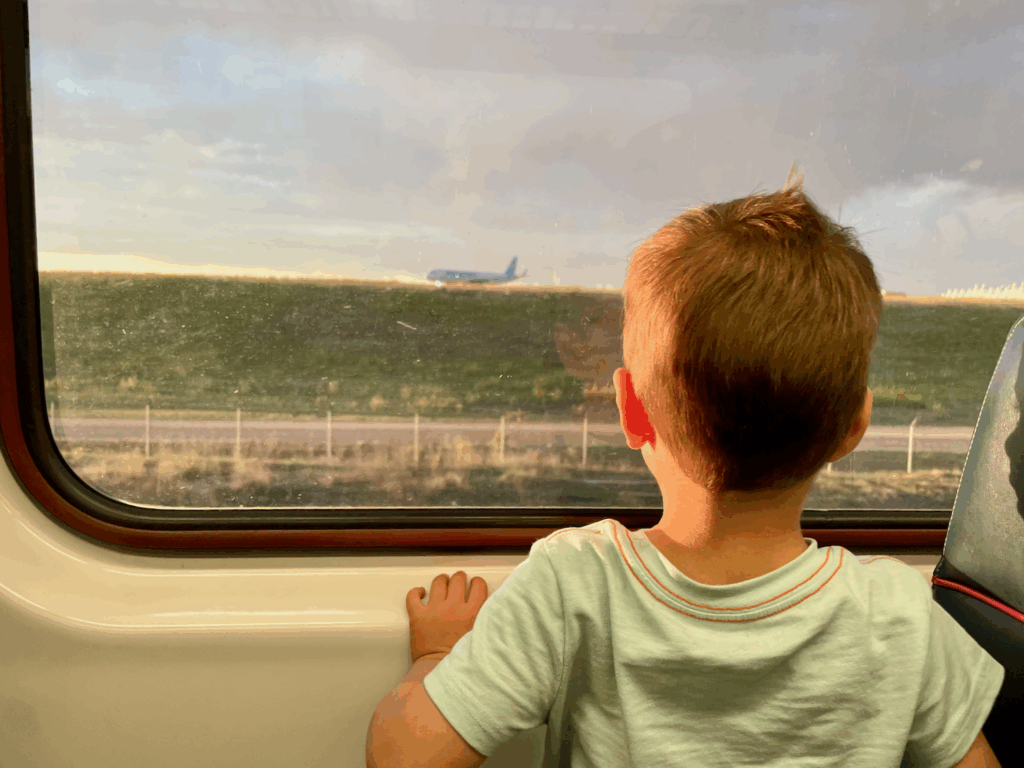
Tips and Tricks
1. Practice sleeping on the go and in new spaces before your trip.
You don’t want the first time your child sleeps outside the comfort of your home to be when you are crammed with a couple hundred strangers in a tube flying 30,000+ feet in the air for 8+ hours. Take some day trips, encourage stroller and front pack naps, sleep overnight somewhere, and build up to the big international flight with some shorter air travel if you can. Our kids are so used to sleeping on the go that they will sleep almost anywhere at this point.
2. Avoid screens on the plane close to bedtime.
For the littlest ones, consider skipping screens altogether to avoid blue light exposure before bed and possible meltdowns when you turn off the screens. That includes your seatback screen.
For the older ones (say an older toddler or preschooler), setting clear expectations ahead of time can be helpful. Before an overnight flight, I may tell my older kids they can watch a movie or show at the beginning of the flight but that once dinner is cleared, all our seatback screens will be turning off. I have them verbally acknowledge this boundary. Then we use their bedtime routine to break up screen time and sleep time.
We practice these kinds of boundaries and transitions all the time at home. “Ten more minutes playing with trains, then we are going to go brush teeth”. Setting clear boundaries that we stick with time after time helps us avoid meltdowns on the plane when the screens power off.
3. Consider skipping meal service.
If the schedule of the plane’s food and beverage service does not fit with your family’s rhythms and routines, consider skipping it!
When we fly out around bedtime or later, I try to have my kids all ready for “bed” before we board the plane. The rumble of the plane often knocks them out. Unless you are dying to eat airplane chicken at 8 pm, I suggest eating dinner before getting on the plane and declining meal service. Sometimes dinner is not served until 1-1.5 hours after takeoff, and the commotion, lights, and clinking of silverware can wake kids up. Then you have to try to get them back to sleep after a nap, which is even harder.
Breakfast is an even easier meal to skip if your family is still asleep when it comes around. You can fill everyone up with something heartier and healthier once you get off the plane.
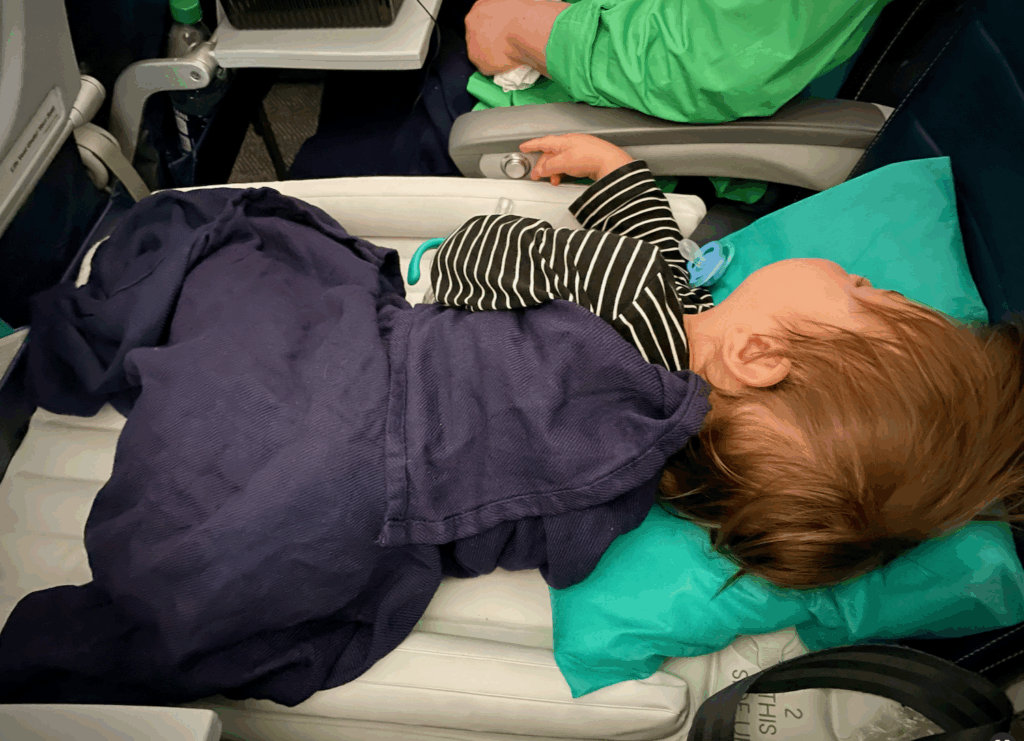
I have never regretted prioritizing my family’s rhythms over the flight’s scheduled service. Recently, I declined dinner and breakfast flying solo with my kids on a redeye from Hawaii to the mainland. The kids started nodding off as soon as we began taxiing to the runway and slept until we landed. I had kids snuggled on me like a pack of puppies. Me eating dinner would have almost certainly woken them up. Since we had eaten dinner before going to the airport, I wasn’t even hungry and it was an easy way to keep everyone asleep.
Even if the flight leaves earlier in the evening (say 6:00 pm), I will consider eating ahead of time. If you have an 8 hour flight, by the time dinner is served, eaten, and cleaned up, you are left with about 6-6.5 hours of sleep at best. That assumes you sleep through preparations for landing and all the way until you arrive at the gate. My older kids are excited by the novelty of eating dinner on the airplane, so we do sometimes eat dinner on early evening flights. But if you have an infant or young toddler, you may want to take the extra sleep!
4. Get yourself ready to rest when you get your kids ready.
Don’t forget to take care of yourself! You don’t want to get everyone all settled and then suddenly realize you have to use the restroom when you have a sleeping baby on your lap. Ideally you would nod off a bit as well. Pull out anything you will want to access before the kids fall asleep. I do try to resist watching anything because my screens can keep my kids awake. But sometimes I will pull my headphones out so I can listen to a podcast or music, or read a book if the cabin lights are still on. And I make sure my water is handy in case I get thirsty.
5. Use your family’s typical routines and daily rhythms to make the days feel as normal as possible despite the time change.
Having rhythms and routines that your children are familiar with is important when you are on the go. You can use that structure to mimic a normal day for your kids, even when nobody knows what time it is. Check out my post on maintaining family routines, structure, and rhythms on the go.
6. Keep naps short and try to take them on the go.
For a baby, who is still taking several naps a day, I would not let any one nap last longer than 2 hours. If I need to throw in an extra catnap to get through the day, I will. But I make sure they have a full age-appropriate wake window between the last nap and bedtime. I push them as much as I can without them getting overtired.
For a really tired older child who only takes one nap a day, I might let them doze early in the morning for half an hour if I am confident it won’t mess with their mid-day nap. Otherwise, I just push their mid-day nap up to as early as 11:30 am local time (eat an early lunch at 11:00 and then go right into nap time) and let them sleep up to 3.5 hours but make sure they are awake by around 3:00pm at the latest. You know your kid best. If any snoozing in the morning makes it hard for your child to fall asleep at nap time, just push through to nap. One of my kids will not take their mid-day nap if they have slept even a wink after breakfast.
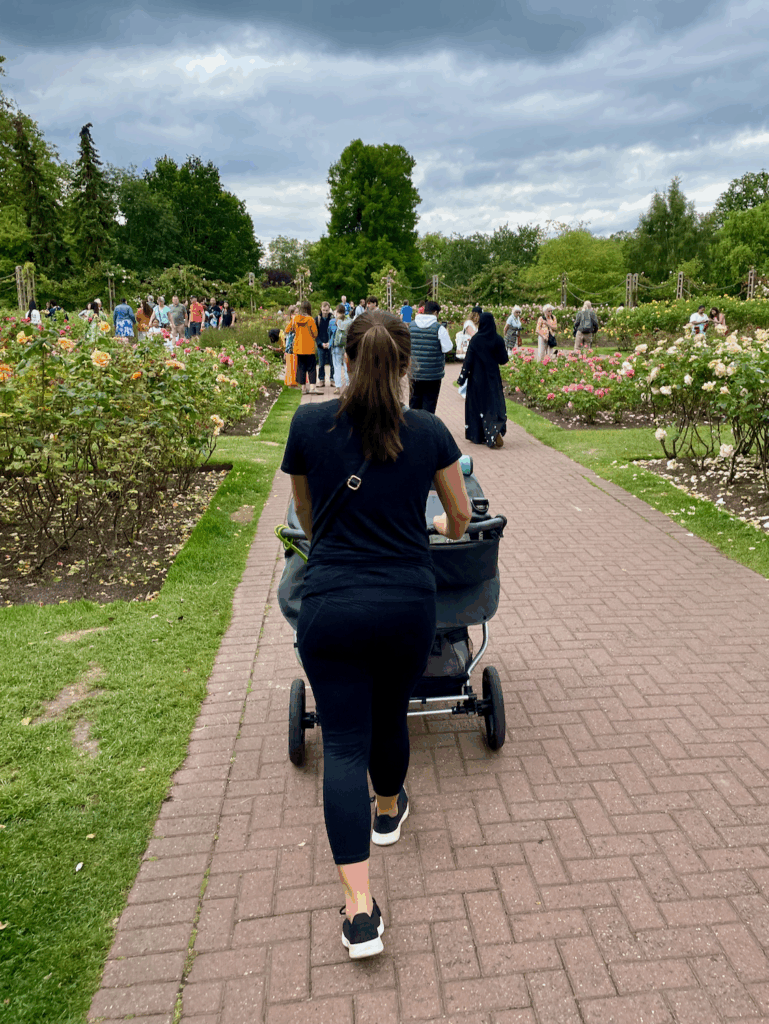
And try to do naps on the go. If I go sit in a dark hotel room with my sleeping babies after an overnight flight, there is a 100% chance that I will fall asleep. I doubt I’m alone in that. I try to keep my body moving and give my kids stroller naps on the days we are adjusting to time changes. It keeps me awake and they get the sleep they need.
This can be brutal. But staying awake until bedtime helps me get on track quickly and is the only way I can avoid jet lag lasting for days. I have given in pre-kids and taken naps on the first day. Each time it took me a long time to adjust. I now know I need to stay disciplined on that first day in order to set us up well for the days that follow.
7. Don’t give in to the jet lag! If you wake up in the night, keep lights off or dimmed.
When your child wakes up in the night (whether on the plane or at your destination), keep lights off or dimmed and encourage them to go back to sleep.
If the baby or young child needs some songs or to read a few books quietly, give that a go. But try to resist turning on screens or switching all the bright lights on in the middle of the night. After a while of unsuccessfully trying to get an older child to fall back to sleep, I might use an audio story to entertain them while the rest of us sleep. They may doze off on their own after listening for a bit. But even some quiet time listening to a story in the dark is more restful than bright lights and flashy screens. The moment those are on, everyone is up for good.
8. Manage your own expectations.
Trying to avoid jet lag is a great goal. But expect that you will not feel sufficiently rested when you land at your destination and that even if you try your hardest to avoid jet lag, your family will experience it to some extent. Focusing on recovering quickly from jet lag may be a more realistic goal.
I try to see any sleep on the plane as a win, rather than counting exactly how many hours deep our sleep deficit is. By framing our limited sleep in more positive light, I find that I am able to more confidently tackle our jet lag instead of feeling like everything is going wrong. Even at home we have rough nights that we manage to recover from. You will too. By utilizing your routines and rhythms over the next couple days, you can help yourself and your little one(s) get back on track if sleep does not go the way you hoped.
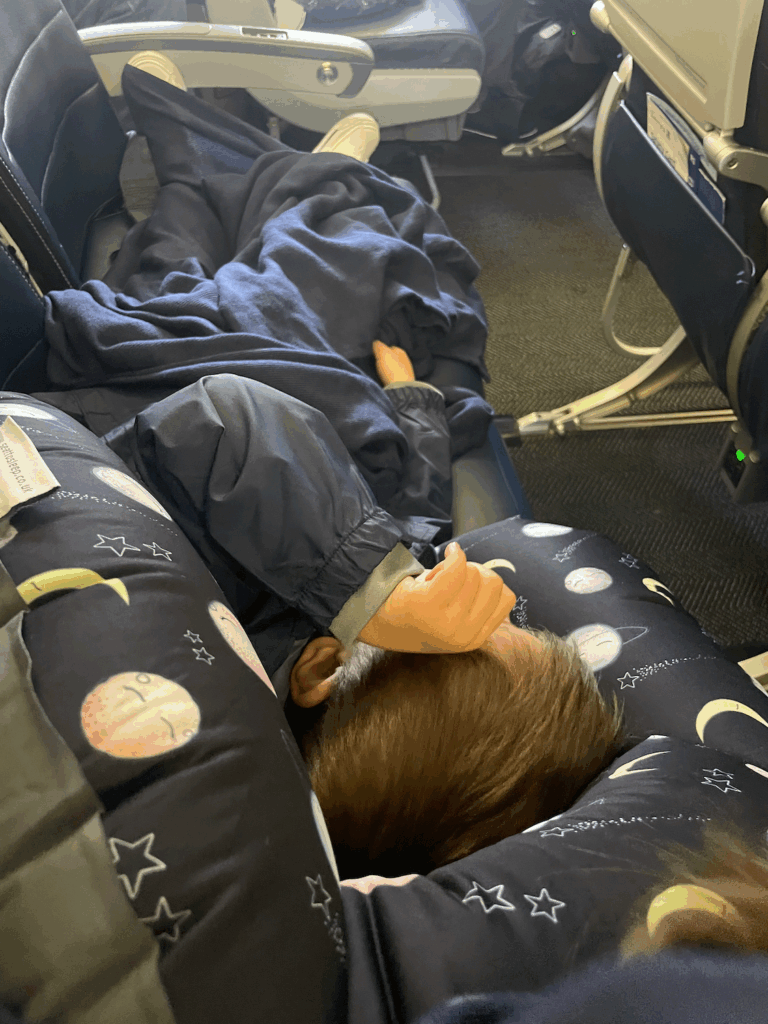
9. Plan for Jet Lag.
Plan that the first couple days everyone will likely be a little tired. If you can avoid it, don’t schedule something you are really excited about on the day you arrive. Not only will you be tired, but if there is a delayed or canceled flight, you don’t want to miss it! Also don’t schedule things early in the morning or late in the evening on the first day or two. But do plan to give your kids plenty of excitement and physical activity on the first and second day so that they tire out and are ready to sleep when it is time.
Here is how this all plays out:
So say we are flying direct from the USA on a Friday evening and landing in Europe mid-morning Saturday. We would try to keep those two days feeling as normal as possible for our kids (even though us parents may be exhausted!).
Pre-flight:
We would stick with usual naps, mealtimes, and rhythms that day. I would make sure to give my kids as much physical activity as possible throughout the day.
5:30 PM – Push back from the gate:
Older kids might watch a show or movie. This is a treat they really look forward to!
6:30 PM – Dinner is served around this time:
Note: If traveling only with a baby (and no older children), we would consider skipping this meal and moving right into the bedtime routine.
7:00 PM – Clean up dinner, screens off, and move into bedtime routine:
Younger ones get a diaper change, maybe a change of clothes, and read a book. We brush our older kids’ teeth and take them to the bathroom to go potty, etc. Basically we do whatever feels like an “official” signal that it is now bedtime. Then we turn off as many lights as possible, and work on getting them to sleep. Hopefully by this time the crew will be dimming the main cabin lights.
I might spend time in the airplane galley gently bouncing a baby or young toddler to sleep in the front pack. When they are older I am just really firm about it being bedtime. It sometimes takes a while, but our kids always fall asleep eventually.
You might be exhausted and not sleep much on the flight, but if you follow the familiar rhythms of their every-day and set the right tone, there is a good chance your kids will sleep at least some of the flight.
9:30 am local time – Landing/first day at your destination.
I would treat this next day like a normal day after a rough night. So if it is 9:30 am when you land, pretend it is 9:30 am at home. Maybe baby’s first nap is right after you get off the plane.
For my older kids, who nap around 1 pm, I try to make it to 11:30 am or noon if I can and give them a solid mid-day nap. Even at home I will move nap time up or back depending on how tired my kids are, so this is not unusual for them.
The baby may need an extra afternoon nap to make it through the day. I would let the child take a solid morning and mid-day nap but try to keep any late naps relatively short (maybe 30 minutes), just as I would if we had a really rough night at home and were dealing with an exhausted child.
6:30/7:00 – Bedtime:
Then for bedtime, I stretch the kids as much as I can without them getting over tired. Going to bed a little early is perfectly fine. My older kids normally go to bed between 7-8 pm. So if I can get them to stay up until 6:30-7 pm, I am happy. I will let them sleep in the first morning, but wake them by 9:30/10 am.
Then just keep repeating your same rhythms and routines each day.
Some final thoughts:
We have had quite a bit of luck with time changes on direct overnight flights. What gets more complicated is when we fly indirect and the second day is also full of disruptive flight times. For this reason, I prioritize direct flights when I can. If that is not an option, just do your best and know it may take a little more time to get settled, and that is ok. You should be proud of yourself for stepping out of your comfort zone and going on the adventure!
On our last trip to Europe, my kids slept around 14 hrs straight the first night at our destination and then were on a good sleep rhythm the rest of the week. But not every trip goes that smoothly and this was not their first trip across the pond. Traveling with young kids gets easier with practice and as you learn what works for your family. So give it a try and then learn what you need to adjust for next time! Safe travels!


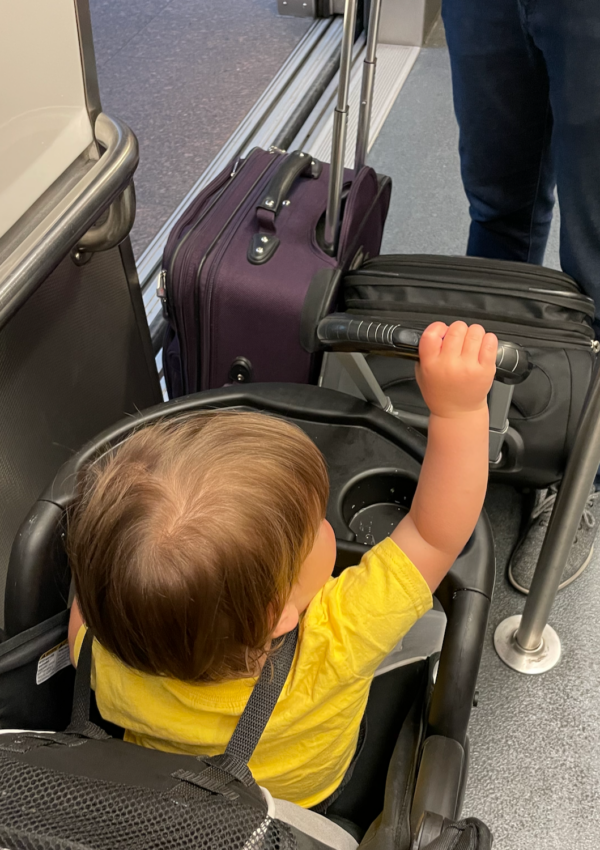


Leave a Reply